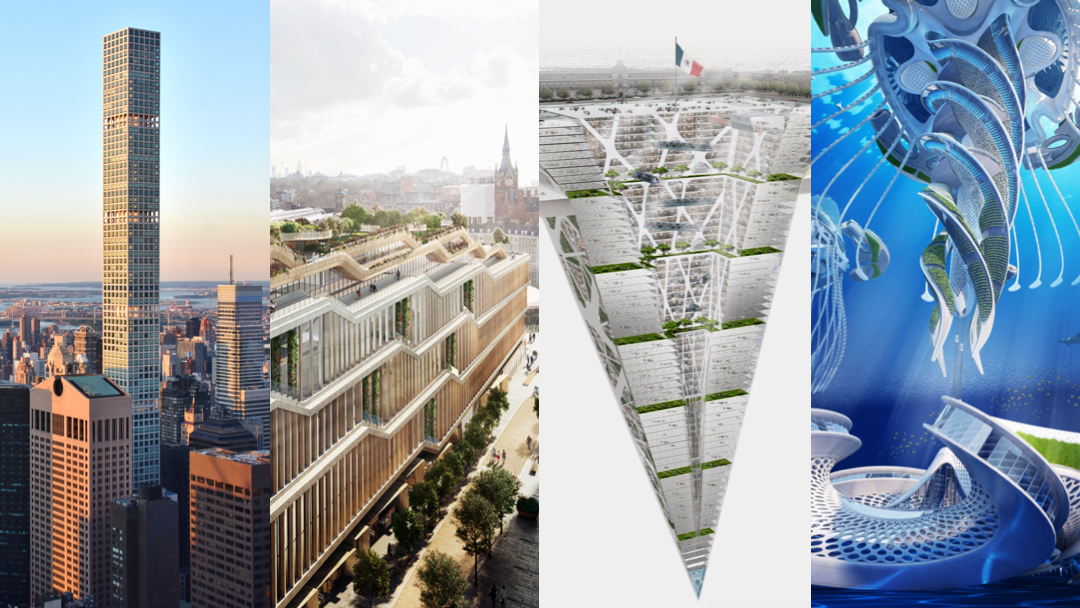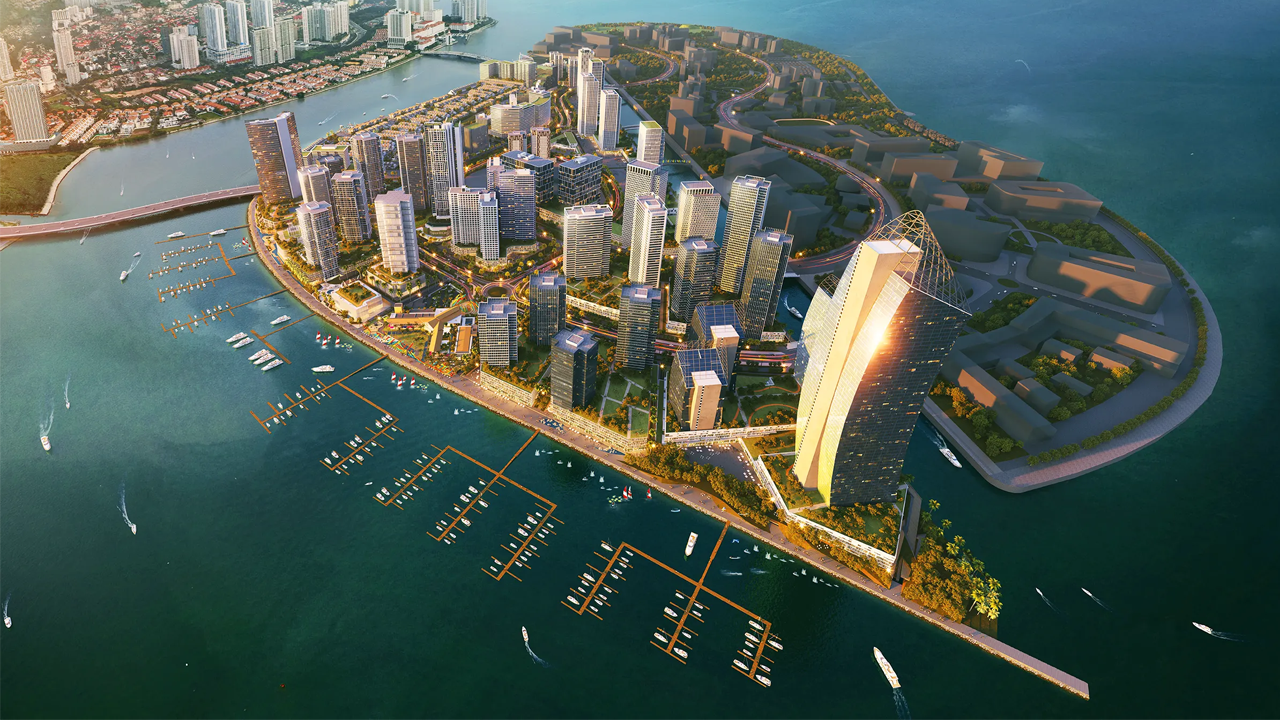
Skyscrapers, Groundscrapers, Earthscrapers and Oceanscrapers explained
Who knew there were so many different types of scraper?
As the global population continues to expand, and as the demand for space within urban areas increases, architects, engineers and developers are coming up with ever more ingenious ways of accommodating people and driving value from the land – and indeed water – on our planet.
Here we take a look at some these amazing concepts and use some of The B1M's award-winning videos to explain the difference between them.
SKYSCRAPERS
Skyscrapers have come to define our cities.
From the early towers of Chicago and New York in the late 1880s, building tall has been the most effective way of maximising floor area and value from a site.
More recently, the demand for high-end residential properties in Manhattan has created the city’s “super skinny” tower phenomenon. The extreme width-to-height ratios of these structures pushes engineering to its limits and drives considerable value from some of New York’s smallest parcels of land. 432 Park Avenue, 56 Leonard Street and 53W53 are all powerful examples of this trend.
To qualify as a true “skyscraper” a structure must be self-supporting and not require tension cables or supports in order to remain standing. In addition, habitable floor space must occupy at least 50% of the structure’s total height. As a result, communication and observation towers - such as Tokyo’s Skytree or Berlin’s Fernsehturm - are not considered to be skyscrapers.
Finally true skyscrapers must rise to a minimum height of 150 metres (492 feet).
While this used to be an exclusive club, there are now countless buildings around the world that fall into the skyscraper definition, and as engineering and construction techniques have continued to develop, humankind has pushed the limits of building at height. To distinguish these remarkable structures from other skyscrapers, the Council on Tall Buildings and Urban Habitat (CTBUH) have created two additional categories: supertall and megatall.
You can learn more about these incredible structures in our free series of skyscraper documentaries.
GROUNDSCRAPERS
Effectively the opposite of a skyscraper, a groundscraper is a large building that sprawls along the ground, rather than soaring into the sky.
The term came to prominence when Google unveiled plans for their new London headquarters. Designed by Bjarke Ingels, Thomas Heatherwick and British architectural practice BDP, the vast USD $1.3BN office block is only 11 storeys high, but more than 1,000 feet (330 metres) in length – as long as London’s Shard is tall.
The building is an example of how extending horizontally, rather than vertically, can provide the large amounts of office space needed for global corporations. The building is set to create over one million square feet (80,000 square meters) of space and become home to some 7,000 Googlers.
In California, tech-giant Apple recently completed “Campus II” – a vast circular-shaped office building that is only four storeys tall, but an incredible one mile in circumference.
Another prominent example is the Vanke headquarters in Shenzhen, China. Designed by American architect Steven Holl, this office block is as long as the Empire State Building is tall.
Proponents of groundscrapers argue that they have many advantages over skyscrapers. They do not impact a city’s skyline, are comparatively cheaper to construct and are more energy efficient, as towers often demand a greater degree of mechanical climate control. Groundscrapers can also create more socially inclusive spaces that encourage interaction between staff and people outside the workplace.
Of course one clear disadvantage is that groundscrapers occupy more land, which can be expensive.
You can learn more about groundscrapers here.
EARTHSCRAPERS
An Earthscraper is best described as an inverted skyscraper.
These structures start at ground level and then extend a considerable distance downwards from the surface.
Although an extremely interesting concept, at present earthscrapers only exist as design concepts, either in fiction or architectural proposals. None have yet been built (as far as we are aware).
The best-known proposal to actually construct an earthscraper was an entry to the Evolo Skyscraper Competition in 2012 by Mexican architectural practice BNKR Arquitectur. Their proposal imagines a 65-storey deep earthscraper placed beneath Mexico City’s central square, the Zócalo.
Plunging 1,000 feet (300 metres) into the earth, the inverted pyramid is intended to contain a 10-floor museum, 10 storeys of housing and 10 storeys of retail units, all above 35 storeys of subterranean office space.
All of these habitable spaces are arranged around a central void that allows natural light and ventilation into the structure. This vast void would be covered with a glazed roof, acting as a floor surface in the square above.
According to BNKR Arquitectur the ambitious plan is a solution that responds to Mexico City’s height regulations limiting new structures to eight storeys in the historic centre, and a huge demand for centrally located property.
However, there are many structural, logistical and regulatory barriers for the project to overcome, and for the time being this earthscraper does not look like being built.
You can learn more about earthscrapers here.
OCEANSCRAPERS
Finally, with humans set to colonise an ever greater area of the planet’s land mass in the decades ahead, a new frontier is now being explored.
Oceans cover more than 70% of the earth’s surface but remain relatively undiscovered and are seen by some as an obvious area to colonise as population expands.
To date this has taken the form of land reclamation projects such as those in Monaco and Hong Kong. There have also been underwater hotels, research facilities and even an under-ocean data centre, which was trialled by Microsoft off the coast of California in 2015.
Now, theoretical concepts for entire underwater communities known as “oceanscrapers” have been floated.
An oceanscraper is an airtight, submerged structure that is built offshore and that can operate independently from land. Free from the constraints of gravity, and relying on the natural buoyancy of their structure, oceanscrapers could in theory be built on a scale not possible onshore.
Some proposals have these structures tethered to the seabed while others are floating and extend downwards from the surface.
In 2015, Belgian architect Vincent Callebaut offered the most detailed concept for an oceanscraper to date using his vision to highlight the pressures that are currently being placed on our oceans.
“Aequorea” is a visionary city that would be built off the coast of Rio de Janeiro. Shaped like a jellyfish, the structure’s cylindrical form allows for natural currents to pass by undisturbed while offering stability and buoyancy in rough seas.
Spanning 500 metres across the ocean surface and extending almost 1,000 meters down into the depths, these oceanic buildings would accommodate 20,000 people and feature apartments, hotels and sporting facilities alongside state of the art research laboratories.
Callebaut’s oceanscrapers would be 3D printed from “algoplast” a hybrid material that would be produced by cultivating marine algae and plastics from the “great garbage patches” floating in the world’s oceans.
This submerged world would be powered by renewables, using solar, wind and wave technology. These particular oceanscrapers would use their surface structures for growing food, while farming algae and molluscs as a source of protein.
Fresh water would be harvested from the surrounding ocean via a desalination process.
Although oceanscrapers remain some way from becoming a reality, with advanced and highly credible proposals already well-developed for human habitations on Mars, the concept of colonising such a large and untapped region of our own planet may not be so far-fetched.
You can learn more about oceanscrapers here.
TREESCRAPERS?
Oh yes, there's more.
In an effort to create a more pleasant, healthier and sustainable built environment, architects, engineers and developers are creating increasingly greener buildings - and doing it in a more literal way than ever before.
Whilst the term "treescraper" hasn't quite caught on - and this particular concept doesn't evolve into a new physical space (like the earth, sky or oceans as the others above do) - we think this video demonstrates the positive physical and psychological impact that incorporating trees into our built environment can have on sustainable development.
You can learn more about treescrapers here.
Which of these concepts is your favourite? Let us know in the comments below!








